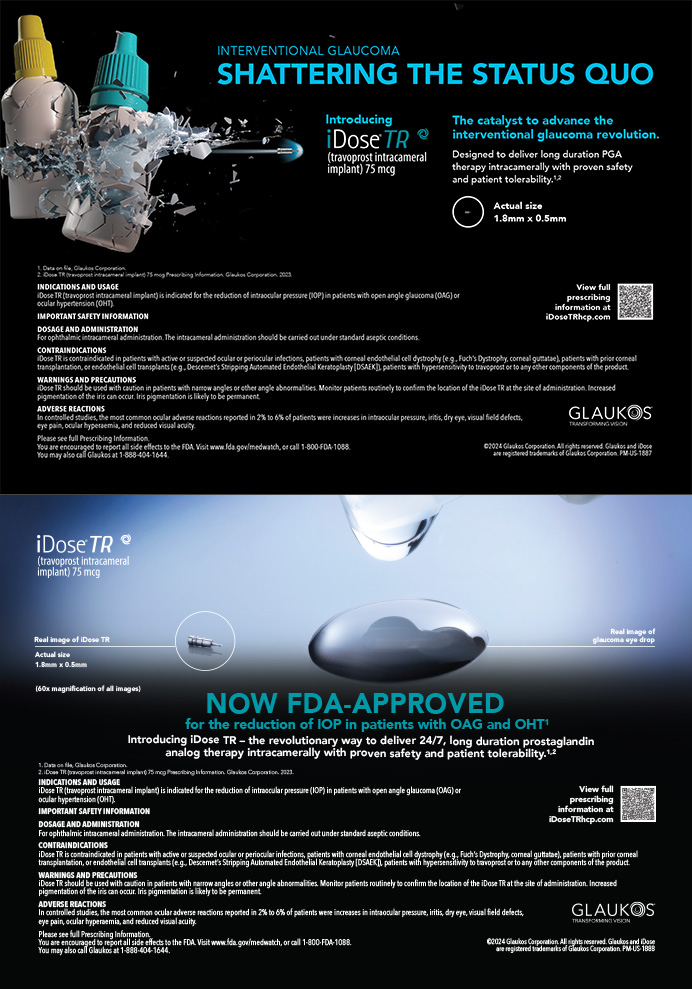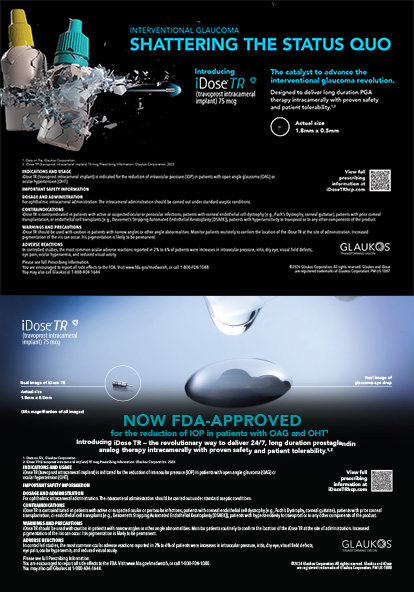In the past few years, ophthalmic surgeons have begun to treat patients suffering from keratoconus and postrefractive surgery ectasia with a simple and relatively low-cost alternative to corneal transplantation. The concepts behind and early research on cross-linking collagen to increase the stiffness of the cornea in eyes with keratoectasia was first introduced decades ago.1,2 Experimental studies have demonstrated that the photosensitizer riboflavin and ultraviolet irradiance strengthen corneal tissue by increasing the collagen covalent bonds, similarly to photopolymerization in polymers.3 Corneal collagen cross-linking (CXL) significantly increases the diameter of collagen fibers. Immunofluorescence confocal microscopy has shown a pronounced compacting of collagen fibers in the anterior stroma of porcine corneas after their exposure to riboflavin and ultraviolet-A light.3,4
FIRST HUMAN TRIALS
In 2003, Seiler et al published the results of the first human trials of CXL. The progression of keratoconus was at least halted in all treated eyes. They found regression with a reduction of the maximal keratometry (K) readings by 2.01 D and of the refractive error by 1.14 D In 16 eyes (70%). The transparency of the cornea and lens, endothelial cell density, and IOP remained unchanged, but visual acuity improved slightly in 15 eyes (65%).5 Subsequent worldwide studies continue to confirm the safety and efficacy of CXL.6,7 Recent research published in the United States has confirmed the results of international investigations, yet the FDA has not approved this treatment.8
Interestingly, recently published, long-term studies of CXL suggest that improvement continues for many years after the initial treatment. Another benefit is that the frequency of retreatment is low. Raiskup-Wolf et al analyzed the results of 241 eyes with a minimum follow-up of 6 months. The corneal steepening decreased significantly by 2.68 D in the first year, 2.21 D in the second year, and 4.84 D in the third year. BCVA improved significantly in 53% of 142 eyes in the first year, 57% of 66 eyes in the second year, and 58% of 33 eyes in the third year, or it remained stable in 20%, 24%, and 29%, respectively. Two patients experienced continuous progression of their keratoconus and underwent repeat CXL procedures. Both of these patients suffered from neurodermatitis on intensive systemic therapy. They were retreated with CXL, as it is believed that the deterioration of the eye and the skin findings were directly related.9
CXL TODAY
Present-day treatment involves CXL as a standalone procedure. Concerns over possible microbial keratitis after epithelium-off CXL10 have led to a debate over formulations, concentrations, and times of riboflavin’s application to the corneal surface with the epithelium intact or removed.8,9,11 After standalone CXL, many patients are able to resume wearing spectacles or contact lenses with satisfactory visual results.12
New innovations by surgeons experienced in CXL include its pairing with other surgical interventions. Kanellopoulos compared simultaneous CXL and PRK with sequential CXL and PRK in a series of almost 400 eyes with an average 3-year follow-up. He found greater improvements in patients’ mean UCVA and BCVA and a greater reduction in spherical equivalent refraction, haze score, and K values in the simultaneous-procedure group.13
Surgeons have also performed CXL on the eyes of patients who had intracorneal ring segments (ICRS) in place. CXL after the implantation of ICRS resulted in additional improvement in UCVA, BCVA, sphere, cylinder, and K values. The combined procedure yielded an additional 1.2 lines (P < .05) of UCVA and 0.36 lines (P < .05) of BCVA. The decrease in sphere, cylinder, mean K values, and steepest K values were 2.08 D (P < .05), 0.47 D (P > .05), 2.22 D (P < .05), and 1.27 D (P < .05), respectively, after ICRS treatment, with an additional 0.5 D (P < .05), 0.15 D (P > .05), 0.35 D (P > .05), and 0.76 D (P < .05) of improvement gained after CXL in each respective parameter.14
REMAINING QUESTIONS
Although the information about CXL is encouraging, questions remain. Should the epithelium be removed or left intact? What is the correct formulation of riboflavin? What percentage of the cornea should be cross-linked? How is the effect of CXL accurately measured? Can CXL be repeated?
CONCLUSION
The benefits of CXL are becoming well known, and treatments are routinely being performed worldwide where the procedure is approved—including all 25 nations of the European Union. While US surgeons anxiously await FDA approval of this exciting technique, research continues in an effort to fine-tune the results for patients.
Shachar Tauber, MD, is the director of ophthalmology research, cornea, and refractive surgery at St. John’s Hospital and Clinics in Springfield, Missouri. He acknowledged no financial interest in the content discussed, although his group is pursuing opportunities to participate in CXL studies. Dr. Tauber may be reached at (417) 820-9743; shachar.tauber@mercy.net.
- Spoerl E,Huhle M,Seiler T.Induction of cross-links in corneal tissue. Exp Eye Res.1998;66:97-103.
- Cannon DJ,Foster CS.Collagen crosslinking in keratoconus. Invest Ophthalmol Vis Sci. 1978;17:63-65.
- Spoerl E,Schreiber J,Hellmund K,et al.Untersuchungen zur verfestigung der hornhaut am kaninchen. Ophthalmologe.2000;97:203-206.
- Bottós KM,Dreyfuss JL,Regatieri CV,et al.Immunofluorescence confocal microscopy of porcine corneas following collagen cross-linking treatment with riboflavin and ultraviolet A.J Refract Surg.2008;24:S715-S719.
- Wollensak G, Spoerl E,Seiler T.Riboflavin/ultraviolet-A–induced collagen crosslinking for the treatment of keratoconus. Am J Ophthalmol. 2003;135(5):620-627.
- Wittig-Silva C,Whiting M,Lamoureux E,et al.A randomized controlled trial of corneal collagen cross-linking in progressive keratoconus:preliminary results. J Refract Surg.2008;24(7):S720-S725.
- Caporossi A,Baiocchi S,Mazzotta C,et al.Parasurgical therapy for keratoconus by riboflavin–ultraviolet type A rays induced cross-linking of corneal collagen:preliminary refractive results in an Italian study.J Cataract Refract Surg.2006;32(5):837-845.
- Hersh P,Greenstein S,Fry KL.Corneal collagen crosslinking for keratoconus and corneal ectasia:one-year results.J Cataract Refract Surg.2011;37:149-160.
- Raiskup-Wolf F,Hoyer A,Spoerl E,Pillunat L.Collagen crosslinking with riboflavin and ultraviolet-A light in keratoconus: long-term results. J Cataract Refract Surg.2008;34:796-801.
- Perez-Santonja J,Artola A,Javaloy J,et al.Microbial keratitis after corneal collagen crosslinking. J Cataract Refract Surg.2009;35:1138-1140.
- Leccisotti A,Islam T.Transepithelial corneal collagen cross-linking in keratoconus.J Refract Surg. 2010;26(12):942-948.
- Trattler W,Rubenfeld R,Cummings A,et al.The future of corneal collagen crosslinking.Roundtable discussion presented at:XXVIII Congress of the ESCRS;September 7,2010;Paris,France.
- Kanellopoulos AJ.Comparison of sequential vs same-day simultaneous collagen cross-linking and topographyguided PRK for treatment of keratoconus.J Refract Surg.2009;25(9):S812-S818.
- Ertan A,Karacal H,Kamburoglu G.Refractive and topographic results of transepithelial crosslinking treatment in eyes with Intacs.Cornea.2009;28:719-723.


